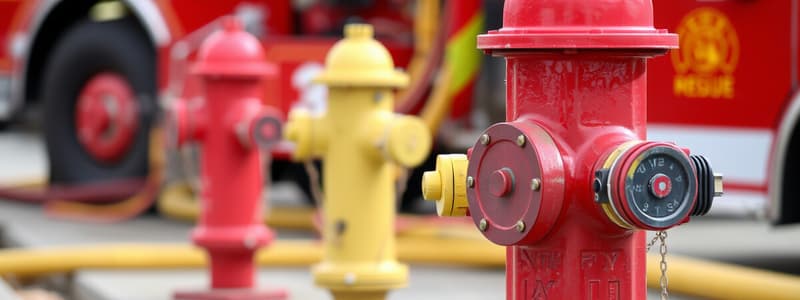Podcast
Questions and Answers
Which step should be followed first when installing a blue reflective hydrant marker?
Which step should be followed first when installing a blue reflective hydrant marker?
How should the blue hydrant marker be positioned relative to the center line on a two-lane highway?
How should the blue hydrant marker be positioned relative to the center line on a two-lane highway?
What should be applied to the back of the hydrant marker during installation?
What should be applied to the back of the hydrant marker during installation?
When installing hydrant markers, what must Unit Officers-in-Charge ensure?
When installing hydrant markers, what must Unit Officers-in-Charge ensure?
Signup and view all the answers
What is the correct direction of the beveled edge when installing the hydrant marker?
What is the correct direction of the beveled edge when installing the hydrant marker?
Signup and view all the answers
On a four-lane highway, where should the blue hydrant marker be placed?
On a four-lane highway, where should the blue hydrant marker be placed?
Signup and view all the answers
What is the required thickness of the epoxy layer applied to the hydrant marker?
What is the required thickness of the epoxy layer applied to the hydrant marker?
Signup and view all the answers
What factor is NOT considered when installing hydrant markers?
What factor is NOT considered when installing hydrant markers?
Signup and view all the answers
Study Notes
Hydrant Location Identification
- Blue reflective hydrant markers are to be installed on roadways for locating fire hydrants.
- Use the Fire Hydrant Maintenance application to verify hydrant locations.
Installation Guidelines
- Markers should align with the hydrant and traffic flow.
- The edge of the marker must touch the edge of the center line of the roadway.
Specific Installation Procedures
- Two-Lane Highway:
- Place the marker in line with the hydrant steamer fitting, next to the center line.
- Ensure the marker is on the side of the center line closest to the hydrant.
- Two-Lane Highway (Corner):
- Align marker with both the hydrant steamer fitting and the 2-½ inch hydrant cap by the cross street center line.
- Four-Lane Highway:
- Install the marker in line with the hydrant steamer fitting, next to the center line, on the closest side to the hydrant.
Attachment Method
- Markers will be affixed using a two-part epoxy paste.
- Prioritize traffic safety and ensure no risk to firefighters during installation.
Application Process
- Determine the marker's position using provided attachments.
- Mix equal parts of epoxy (Part "A" and Part "B") to form a gray paste.
- Apply a 1/8-inch thick layer of epoxy on the back of the marker.
- Firmly press the marker down, allowing excess epoxy to flow around its sides.
Important Notes
- Markers are reflective from both front and back and should be oriented with traffic direction during installation.
Studying That Suits You
Use AI to generate personalized quizzes and flashcards to suit your learning preferences.
Description
This quiz covers the essential procedures for installing blue reflective hydrant markers on roadways. Learn how to verify hydrant locations and follow installation guidelines to ensure effective identification. Understanding these installation techniques is crucial for fire rescue personnel.



